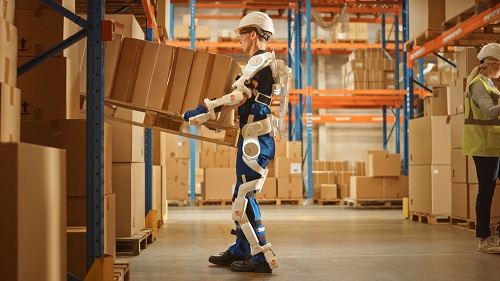Visions of superheroes running in exoskeletons able to move faster, jump higher, and hit harder are a mainstay of popular culture. However, for workers who want to increase strength and avoid common workplace injuries, exoskeletons are now a reality.
What started as a military tool to help soldiers carry large loads has evolved to have applications in manufacturing, warehousing, construction, medicine, and more. Industrial exoskeletons are wearable devices for the worker’s hand, lower back, or shoulders to aid in heavy lifting and reduce musculoskeletal injuries. Like all technology, if not used correctly, it may create risks for its users. These tips can help:

1 Train workers in safe exoskeleton operation.
Before using, train workers in the safe usage of the exoskeleton. Always follow the manufacturer’s instructions when training on and operating the exoskeleton.
2 Wear proper personal protective equipment (PPE).
When using an industrial exoskeleton, wear the proper PPE for the job. This includes additional safety features that come with the exoskeleton, such as a safety belt, gloves, or full-body harness.
3 Fit the exoskeleton to the user.
Adjust the exoskeleton for the correct fit. Improper fit puts the worker at risk when lifting and shifting large objects. These steps can help create a custom fit:
- Measure and record the size and shape of the user's body.
- Add padding to the exoskeleton's harness to reduce pressure on the user's skin.
- Check the user's range of motion to make sure the exoskeleton does not interfere with movement.
- Test the exoskeleton's flexibility and adjust its tension to get a comfortable fit while still supporting the user's movements.
- Adjust the straps and buckles to prevent the exoskeleton from slipping.
- Ask the user to walk around to see if the exoskeleton fits properly.
- Make sure the user feels comfortable and make any adjustments needed.
4 Use the exoskeleton only for its intended purpose and environment.
Exoskeletons are not right for all tasks. Never use the exoskeleton in ways that exceed its weight-bearing capacity. Avoid using the exoskeleton for jobs that put the user in repetitive movements or awkward positions. Always be aware of the surroundings, particularly if the task involves walking, running, or going up and down stairs.
5 Take breaks as needed.
The metal components of exoskeletons will heat up during use, which could lead to heat stress. The added weight of the exoskeleton may also increase body temperature and strain. When using an exoskeleton, monitor for signs of fatigue or heat-related illness. Take time away from tasks as needed.
6 Regularly inspect and maintain the exoskeleton.
Inspect the exoskeleton before each use to make sure all parts are in good working order. If the exoskeleton includes sensors, check their calibration, sensitivity, and accuracy. Make sure the exoskeleton is regularly maintained. Notify a supervisor of any concerns and repair any damage to the system quickly to avoid injuries.
The use of exoskeletons in the workplace and their safety is still being tested. The American Society for Testing and Materials (ASTM) recently approved the first standards for exoskeletons. Other organizations such as the National Aeronautics and Space Administration (NASA), the American Society of Mechanical Engineers (ASME), and the Occupational Safety and Health Administration (OSHA) are expected to provide voluntary guidance within the next few years.
If you have an on-the-job safety concern, contact a DWC safety training specialist at 1-800-242-7031, option 2.
